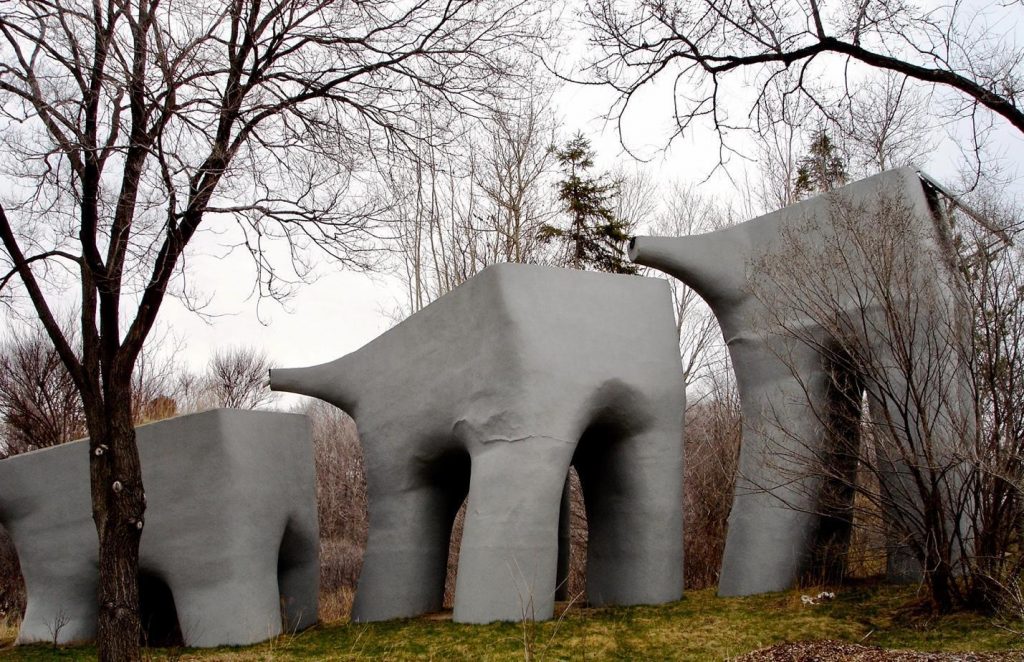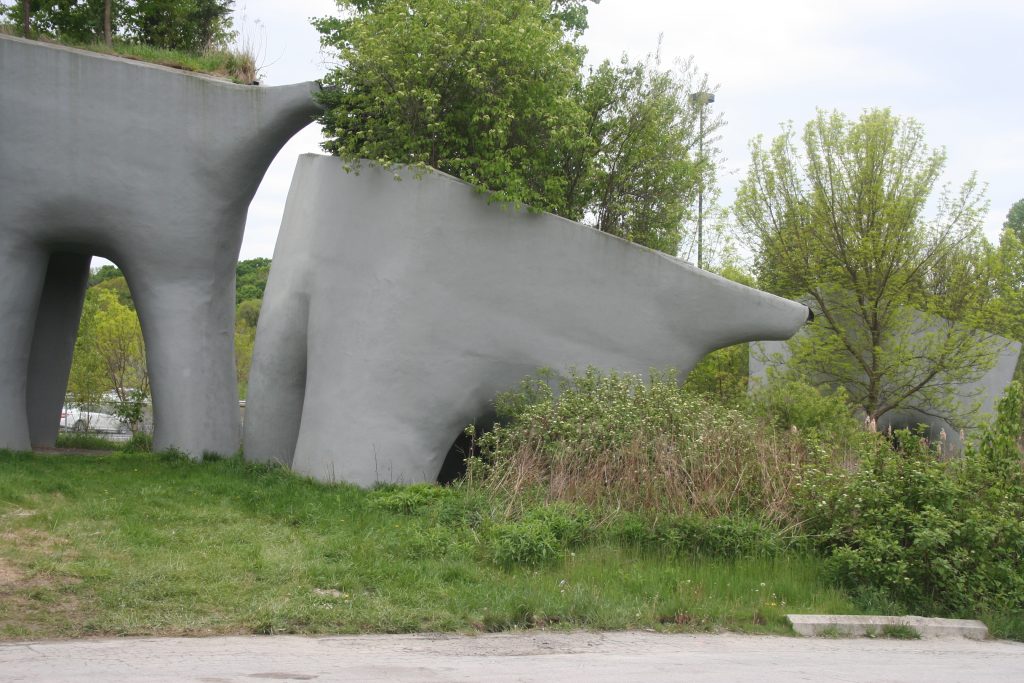The Elevated Wetlands (1997-98)
by Mark Cheetham

Six elephantine shapes stand—or do they graze?—in two groups, one on either side of one of Canada’s busiest highways, the Don Valley Parkway in Toronto.[1] The grey forms are gigantic (approximately 2-3 meters); they seem alive and unperturbed by the traffic, yet also like creatures from a prehistoric past. Visually intriguing, the artwork becomes even more compelling the more one knows about its innovative creation—it is largely made from forms of plastic—and its environmental purpose.
Where and why
The Elevated Wetlands stands in Taylor Creek Park, an oasis of wetlands in the expansive Don Valley, named for the once heavily polluted Don River that runs through the east part of Toronto and into Lake Ontario. Named Wonscotanach in Anishnaabemowin (also called the Ojibwe language), this glaciated valley registers layers of environmental and human history, from the course of the river and its tributaries and still-thriving original plants, to traces of Indigenous settlements more than 5,000 years old and the nineteenth-century mills and brickworks that helped to build the infrastructure of North America’s third largest urban area. Completed in 1998 by well-known Toronto artist Noel Harding in collaboration with landscape architect Neil Hadley, the work was the result of extensive civic planning, local consultation, and partnership with the plastics industry.[2]
Functioning eco art
The Elevated Wetlands is one of the first and most enduringly effective pieces of eco art in Canada. Elevated Wetlands is a working water filtration system. Water from the adjacent wetlands is steadily pumped to the top of the chain of sculptures by solar voltaic systems (solar panels attach adorably to the backsides of some of the “elephants”). Gravity then takes the water through a simple filtration system. Treated waste from plastic bottles, automobile plastics, and shredded consumer plastics cooperates with local wetland flora atop each form to absorb and filter chemicals and other contaminants. A much cleaner sample of stream water is then returned to the soil beside the Don River. An affirmative example of the potential “green” collaboration between industry, art, and civic planning, the sculptural group is also clearly art because it is so unusual and more than strictly functional. The plastic sculptural structures topped with plants interact with one another organically, as groups of animals often do. Nose to tail, they are intimate, tactile, and purposeful. Most of all, the groups strike one as playful.
Questions raised: Practicality and/versus aesthetics in eco art
Pioneering in its sculptural presence and its green agenda, The Elevated Wetlands continues to serve as a unique water filtration apparatus, an example of collaboration and an aesthetically captivating installation. As plastic becomes more and more of an environmental burden in the present, the work not only suggests but also puts sustainability into practice. Or does it? The sculptures do function, but slowly. Alone, they cannot significantly purify the Don wetlands, nor were they intended to. Harding was not providing a water filtration prototype suited to similarly polluted areas at scale, similar to the power-generating windmills we see in some locales. The Elevated Wetlands is practical—ameliorative—in a symbolic way. As eco art, the work raises issues and demonstrates solutions. If it were strictly practical, it would no longer be art. Yet The Elevated Wetlands continues to pose environmental questions in part because—hurtling past it on the highway or admiring it close up—most people don’t register the forms as “art” at all. Its environmental message sneaks up on the viewer.

The Elevated Wetlands is familiar to many Torontonians, but its international importance has been overlooked. Delivering what many today want from eco art—aesthetically engaging art that carries a clear environmentalist message—it is an early example of the environmentally sensitive art which artists have been increasingly taking up in the USA and Europe since the 1990s. In presenting sustainability rather than providing habitat restoration on a large scale, The Elevated Wetlands can be compared with the eco art projects of Newton and Helen Mayer Harrison, which began in the 1970s and continue. The Harrisons describe themselves as “historians, diplomats, ecologists, investigators, emissaries and art activists.”[3] Though not a functioning work in Harding’s sense, their Greenhouse Britain (2007–09), for example, was a large-scale and multi-platform artwork that demonstrated the effects of accelerating planetary warming on the coastlines of the UK. Another fruitful comparison with Harding’s work is Hans Haacke’s Rhine Water Purification Plant (1972). Downstream from the Krefeld sewage treatment plant, he collected still-polluted water, which he purified so that goldfish could survive in the large water tank central to his installation. More politically motivated than The Elevated Wetlands—the artist was calling out the water treatment company, which was a donor to the art museum—Haacke’s cleansing apparatus was installed indoors for two months at the Museum Haus Lange in Krefeld, Germany.
Eco art and public art
These three works have a strong aesthetic impact and also ask what eco art can be and do as art. A notable difference between The Elevated Wetlands and many other eco artworks, however, is that Harding’s work is also a prominent and permanent piece of public art. It does not filter or control its audiences in the way that museum exhibits inevitably do. The Elevated Wetlands was designed to be and remains part of the elaborate web of civic, technological, and aesthetic discussions and controversies that uniquely attend public art. As public art, it continues to pose environmental questions to a broad range of people through an unusual and laudable combination of ecological insight, technological savvy, and whimsy. It is a work for its immediate locale, for the past of this environment and its peoples, and for the future of the planet.
About the author
Dr. Mark Cheetham is a professor of Art History at the University of Toronto who specializes in modern and contemporary art. He has published broadly on a number of topics, including ecocritical art history. His most recent book is Landscape into Eco Art: Articulations of Nature since the ‘60s (Penn State UP 2018).
Further reading
Cheetham, Mark A. Landscape into Eco Art: Articulations of Nature since the ‘60s. University Park: Penn State University Press, 2018.
Knight, Cher Krause, and Harriet F. Senie, eds. A Companion to Public Art. Oxford: Wiley Blackwell, 2016.
Patrizio, Andrew. The Ecological Eye: Assembling an Ecocritical Art History. Manchester: Manchester University Press, 2019.
Eco Art makes its primary concern the “natural” environment, broadly defined, and explores the interactions of people, animals, and materials in this realm.

